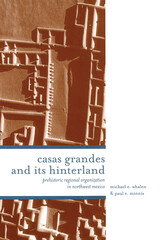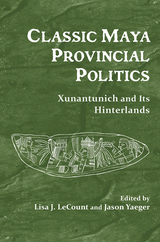2 books about Its Hinterlands

Casas Grandes and Its Hinterlands
Prehistoric Regional Organization in Northwest Mexico
Michael E. Whalen and Paul E. Minnis
University of Arizona Press, 2001
Casas Grandes, or Paquimé, is one of the most important settlements in the prehistoric North American Southwest. The largest and most complex community in the Puebloan world, it was characterized by its principal excavator, Charles Di Peso, as an outpost of the Toltec empire, which used it as a trade link between Mesoamerican and southwestern cultures. Michael E. Whalen and Paul E. Minnis have worked extensively in the Casas Grandes area and now offer new research arguing that it was not as similar to the highly developed complex societies of Mesoamerica as has been thought. In the first book of its kind in 25 years, the authors analyze settlement pattern data from more than 300 communities in the area surrounding Casas Grandes to show that its Medio period culture was a local development. Whalen and Minnis propose that Casas Grandes lacked extensive stratification, well-established decision-making hierarchies, and formalized positions of authority. They suggest instead that emerging elites used bribes, promises, and threats to build factions and extend their power. The communities at the periphery are shown to have had varying levels of social and economic interaction with Casas Grandes. This innovative study offers a new model for the rise and fall of Casas Grandes that departs considerably from the view most scholars have come to accept and will be of interest to all concerned with the comparative study of emergent complexity. It clearly shows that the idea of extensive regional centralization by Casas Grandes is no longer tenable and merits reconsideration by the archaeological community.
[more]

Classic Maya Provincial Politics
Xunantunich and Its Hinterlands
Edited by Lisa J. LeCount and Jason Yaeger
University of Arizona Press, 2010
Most treatments of large Classic Maya sites such as Caracol and Tikal regard Maya political organization as highly centralized. Because investigations have focused on civic buildings and elite palaces, however, a critical part of the picture of Classic Maya political organization has been missing.
The contributors to this volume chart the rise and fall of the Classic Maya center of Xunantunich, paying special attention to its changing relationships with the communities that comprised its hinterlands. They examine how the changing relationships between Xunantunich and the larger kingdom of Naranjo affected the local population, the location of their farms and houses, and the range of economic and subsistence activities in which both elites and commoners engaged. They also examine the ways common people seized opportunities and met challenges offered by a changing political landscape.
The rich archaeological data in this book show that incorporating subject communities and people—and keeping them incorporated—was an on-going challenge to ancient Maya rulers. Until now, archaeologists have lacked integrated regional data and a fine-grained chronology in which to document short-term shifts in site occupations, subsistence strategies, and other important practices of the daily life of the Maya. This book provides a revised picture of Maya politics—one of different ways of governing and alliance formation among dominant centers, provincial polities, and hinterland communities.
The contributors to this volume chart the rise and fall of the Classic Maya center of Xunantunich, paying special attention to its changing relationships with the communities that comprised its hinterlands. They examine how the changing relationships between Xunantunich and the larger kingdom of Naranjo affected the local population, the location of their farms and houses, and the range of economic and subsistence activities in which both elites and commoners engaged. They also examine the ways common people seized opportunities and met challenges offered by a changing political landscape.
The rich archaeological data in this book show that incorporating subject communities and people—and keeping them incorporated—was an on-going challenge to ancient Maya rulers. Until now, archaeologists have lacked integrated regional data and a fine-grained chronology in which to document short-term shifts in site occupations, subsistence strategies, and other important practices of the daily life of the Maya. This book provides a revised picture of Maya politics—one of different ways of governing and alliance formation among dominant centers, provincial polities, and hinterland communities.
[more]
READERS
Browse our collection.
PUBLISHERS
See BiblioVault's publisher services.
STUDENT SERVICES
Files for college accessibility offices.
UChicago Accessibility Resources
home | accessibility | search | about | contact us
BiblioVault ® 2001 - 2024
The University of Chicago Press









